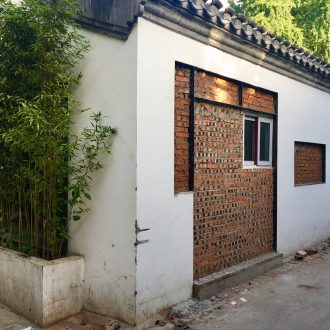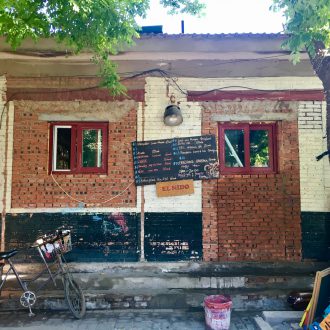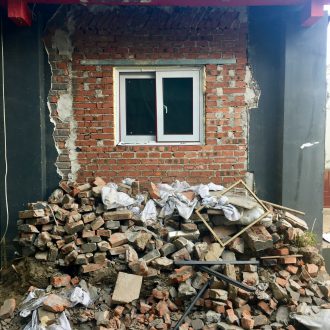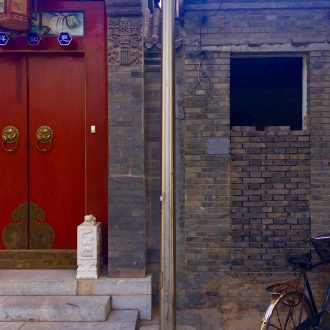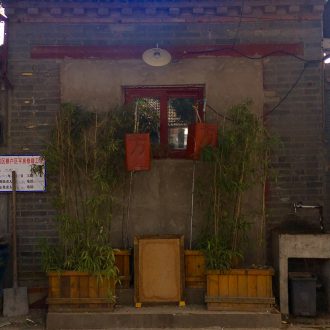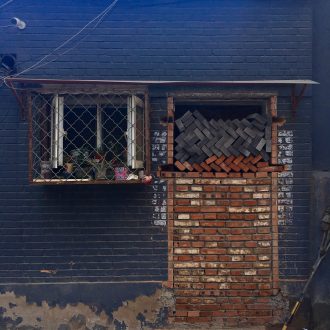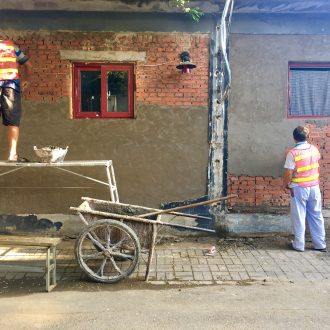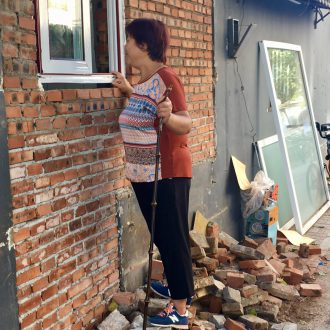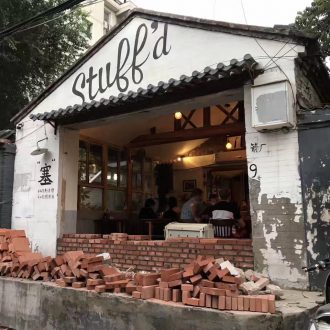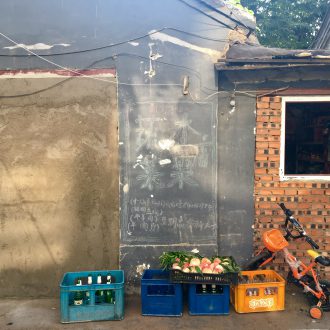
Transforming Concrete: The Impact of Urban Redevelopment on Beijing’s Independent Art Spaces
Zandie Brockett
There was a flurry of activity as my rickshaw pulled around the corner onto Jianchang Hutong. A dozen and a half men not much older than college graduates, though likely without degrees themselves, were dressed in the black teqin (special guard) uniforms. My heart sunk. I knew the same fate disfiguring the hutongs, or alleyways snaking through Beijing historic center, had finally arrived at the small lane that I called home.
They stood guard — taking no responsibility for what was being done to these neighborhood shops, restaurants and markets. They were merely “following orders,” ensuring shop owners remained docile as construction workers boarded up windows and doors to the spaces where they still paid rent. These teqin and construction-worker tag-teams were enacting the central government’s newest plan of ‘urban beautification’ that aims to ‘restore’ the hutongs to their ‘original,’ pre-development conditions. In reality, however, it’s a plan to rid the city of the “uncontrolled development and ‘low end’ entrepreneurship, while pushing out millions of [domestic] migrants” that have come to call Beijing home over the past decade or two. It is a plan that seeks to make way for development of a “futuristic capital of government, finance, media and technology” (NY Times) and is a move that is in anticipation of the upcoming five-year CCP meeting this fall.
In April 2015, I wrote the article, “Two Roads Diverged: The Beijing International” for LEAP magazine. The piece highlighted how it was in these hutong spaces that a network of expats, including artists, designers, archives, musicians, filmmakers and writers were removed from the pressures for conformity to institutionally-driven discourse centered around Western critical theory, social expectations that held them to market demands and, to an extent, an unspoken tendency towards self-censorship. The article further illuminated that resultantly, hybridity and experimentation coupled with a DIY and process-driven aesthetic reigned king in central Beijing (Brockett, LEAP).
But now, newly masoned brick walls stood in lieu of the portals into neighborhood hangouts and sundry shops that both enabled a small economy for domestic migrants, and also provided sustenance for Beijing’s independent creative class. The organic textile shop, a small bodega, a western market, a vegetable stand, the independent space Arrow Factory, a bakery, and the local artist watering hole, Wujin — the rickshaw rolled passed the now boarded holes-in-the-wall that made life in this antiquated, though romanticized part of the capital, convenient and pleasant. Starting roughly six months prior, this process of demolition has slowly crept through not only the hutongs, but also throughout the city, into many migrant or temporary villages on the outskirts of Beijing and even throughout the country as a whole. Violently invading the territories and minds of urban dwellers while forcing public spaces and conversations behind the veil of opaque bricks, the incessant jackhammering and mounds of construction rubble corroborating the destruction is undeniably transforming hutong life. It is also, inevitably, impacting Beijing’s independent spaces.
In April, the independent exhibition space and hair studio, Aotu, was forced to remove its second floor and roof deck terrace that served as an gathering spot and watering hole for Beijing’s independent creatives. Luckily it still operates as a cafe cum gallery and screening space. Wujin, which doubles as a breakfast bar and independent bookshop and is operated by Arrow Factory founders, Rania Ho (USA) and Wang Wei (China) received a similar fate. As bricks went up on the hutong-facing side, a hole was cut through the space’s back wall, theoretically allowing visitors to enter through the interior courtyard. One hutong door per courtyard, so the ‘original’ urban plan was designed, and to this ‘original’ plan the current government wishes to return. Unfortunately, though, the courtyard neighbors are unfriendly and both Ho and Wang are worried their unwelcoming attitudes with deter Wujin customers. Till now, the bar remains closed.
Fortunately, Arrow Factory maintained more control over its fate. Artist Yang Zhenzhong installed his “Fences,” a bricked, plastered and painted grey wall that supplants the former glass wall, which previously allowed passerby’s easy observation of the interior site-specific installations. Half way up the new wall sits a one-way mirror interspersed with prison-like bars. Hutong bystanders peering into the ‘window’ are blind to what lies within —a continuously running CCTV camera recording their every move whose feed is projected at some undisclosed location. Yang’s installation subtly nods to the imprisoned victims we have become at the behest of our increasingly vigilant Big Brother.
Other spaces have transformed, though more for reasons of impermanence inherent in transient expat life. Chen Shuyu and Max Gerthel, co-founders of the well-reputed project space and residency, Institute for Provocation (IFP), returned home to Sweden. Interestingly, two young Chinese artists, Hu Wei and Dai Xiyun, the art critic, Song Yi, and Chen Shuyu (still participating remotely) form the new, entirely Chinese collective managing IFP’s programs. It is a unique though welcomed entry of locals into the generally foreign-led independent scene. The in-home gallery, Jiali, founded and directed by Daphne Mallet, closed just this summer as Mallet returned home to France. Intelligentsia abandoned their Dongwang Hutong space, as founders deemed their space a mere two-year experimentation.
In contrast to the closings and movings, I-Project Space, helmed by the Hungarian Anna-Viktoria Eschbach and German Antonie Angerer, has expanded. Earlier this summer, they opened a new space in the area surrounding the Baitase temple, just slightly West of Beijing’s central axis. The new exhibition space also houses two studios for their residents. Also new to town over the past two years are a series of spaces, including Yue Space, a cafe cum vinyl shop + live-house with many performative ongoings; Fruity Space, an underground den with performances by experimental musicians; Wyoming Project, a space dedicated to exhibitions and publications; Salt Project, a micro-exhibition space; Hutongπ(pi), a community-oriented organization dedicated to researching and recording hutong transformations; and Q-Space, a grassroots maker space dedicated to empowering the LGBTQ+ community. Other independent projects, such as the Social Sensibility Research + Development (SSR+D) department at the Bernard Controls factory in Beijing’s southeasterly industrial quadrant remain protected under the auspices of the company in which its embedded. Projects, such as SSR+D, that cooperate (despite its ultimate mission to subvert and disrupt the organizational status quo) with entities legally established in China, provide both an alternative and speculative model to create and organize independent practices in the current political clime.
But perhaps the tightening of reigns and increase of physically oppressive thresholds will force the independent scene back underground, where it can ruminate on its multifold layers of experimentation and resurface with force and rigor in a few years time. I recently envisioned a reemergence of the experimental and performative practices that proliferated the ’80 art scene before it was bound to any market demands or institutional definitions. Those that were held in new though still abandoned parking lots, as cars had not yet become an economically attainable mode of transportation, or in the empty basements of recently constructed residential buildings before the domestic migrants had even found their way to Beijing. As I dreamed, I told my friend — ‘If the CCP started in the privacy of a French Concessionary atelier, imagine what else could brew behind closed doors!’ She looked at me curiously. But whether catching the glimmer of excitement in my eye, merely conditioned by decades of unscrupulous urban transformation, or perhaps just wary of the current administration, she slyly riposted, “Yes, but then the government turned a blind eye. I’m not so sure about now.” We’ll see what happens as the dust settles.
References
Brockett, Zandie. “Two Roads Diverged: The Beijing International,” LEAP, March/April 2015.
Meyers, Steven Lee. “A Cleanup of ‘Holes in the Wall’ in China’s Capital,” New York Times, Asia Pacific Desk, Beijing Journal. July 17, 2017.


